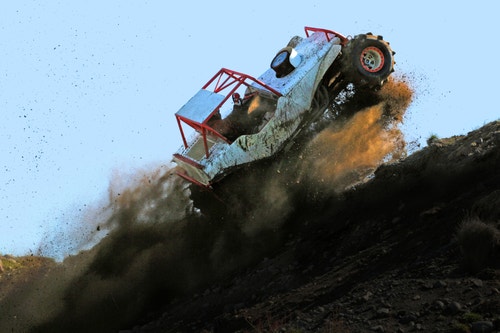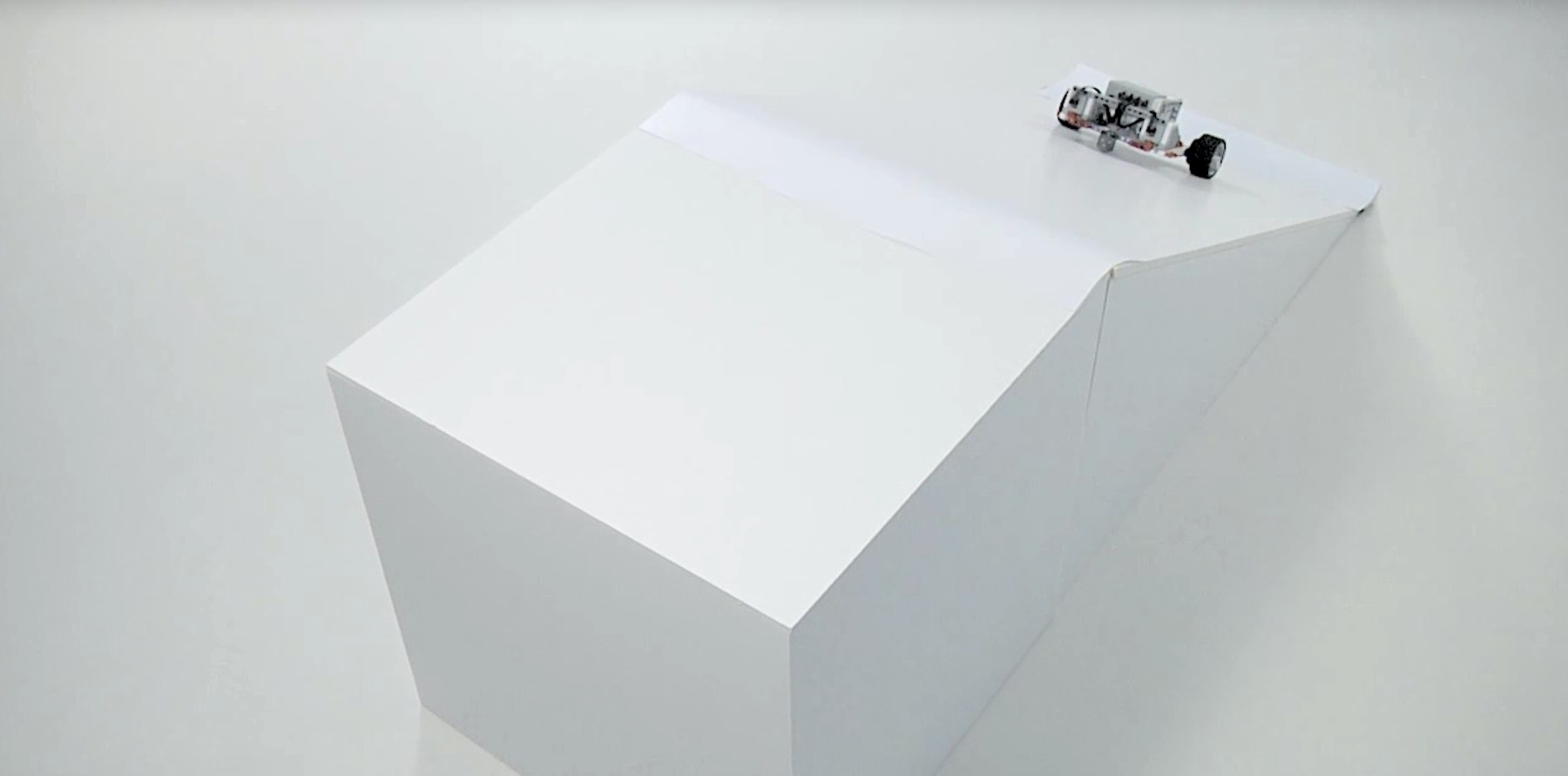Drive Up a Slope
Design, build and program a robot that can move up the steepest possible incline.

Lesson plan
1. Prepare
- Read through the pupil material in the EV3 Classroom App.
- You’ll need a long board or foam board to construct the ramp; and books, blocks or other objects for adjusting the incline during this lesson.
- Use a protractor to measure the incline in degrees, or a tape measure to measure the incline by rise over run.
- To ensure a fair competition, make sure that each EV3 Brick has a fully-charged EV3 Rechargeable Battery or fresh batteries.
- If you don’t have double-block class time, plan to run this lesson over multiple class sessions.
Part A
2. Engage (10 Min.)
- Use the ideas in the Ignite a Discussion section below to engage your pupils in a discussion relating to this lesson.
- Explain the project brief.
- Divide your class into teams of two pupils.
3. Explore (35 Min.)
- Have each team brainstorm ideas for designing a robot that can drive up a steep incline.
- Encourage them to create multiple prototypes, exploring both building and programming.
Part B
4. Explain (10 Min.)
- Have each team try to drive up the ramp at least three times, and record their results.
- Make sure that they can create their own testing tables.
5. Elaborate (35 Min.)
- Let them continue to work on their robots until they’re ready to complete the challenge.
- Don’t forget to leave some time for cleanup.
6. Evaluate
- Give feedback on each pupil’s performance.
- Evaluate the creativity of their solution and how well their team worked together.
- To simplify the process, you can use the assessment rubrics that have been provided.
Ignite a Discussion
Formula Off Road is a competition in which drivers compete on extreme terrain, including steep hills. Driving up a steep incline may seem like a silly thing to do, but building a vehicle that can make it to the top requires some serious knowledge of torque, gears and friction. The competition was invented in Iceland to raise money and awareness for rescue teams, who must overcome extreme terrain in order to save lives.

Use these questions to engage your pupils in a discussion about driving up an incline:
- How would you define a steep incline?
- Can you think of any situations in which being able to drive up a steep incline would be useful?
Project Brief
Design, build and program a robot that can move up the steepest possible incline.
Here is a sample solution that meets the project brief criteria:

Building Tips
Open-Ended Solutions
This project is designed so that every team can have a unique solution. Use these questions to help the teams brainstorm ideas for solving the project brief:
- How can gears be used to increase motor power?
- How will the requirement of having to move up an incline affect how you design your robot?
Setting Up the Adjustable Ramp
To create an adjustable ramp, use a long board or foam board that’s about 1 metre long. Use books, blocks or other objects to adjust the angle of the incline.
Running the Test
As they’re testing their solutions, remind your pupils of the following:
- Record the trial number, incline angle, gear ratio and motor power in a testing table. Make sure to leave enough space for recording other observations.
- Test your robot on at least three different incline angles.
- Test after each adjustment to determine its effect.

Example Solution
This example solution meets the project brief criteria:
Coding Tips
Solution Program

Differentiation
Simplify this lesson by:
- Helping your pupils to figure out how to gear down to increase the mechanical advantage of the motors
- Encouraging peer-to-peer learning and coaching
Take this lesson to the next level by:
- Challenging your pupils to see which of the teams can drive up a steep incline the fastest
- Creating a ramp using a sturdy board with a slightly slippery surface
Assessment Opportunities
Teacher Observation Checklist
Establish a scale that suits your needs, for example:
- Partially accomplished
- Fully accomplished
- Overachieved
Use the following success criteria to evaluate your pupils’ progress:
- The pupils have designed a robot that meets the requirements of the project brief.
- The pupils have understood how to use gearing to increase their robot’s torque.
- The pupils have come up with creative solutions and considered multiple solutions.
Self-Assessment
Have each pupil choose the level that they feel best represents their performance.
- Bronze: I’ve created a robot that can move on a flat surface.
- Silver: I’ve created a robot that can go up a shallow incline (15 degrees).
- Gold: I’ve created a robot that can go up a steep incline (30 degrees).
- Platinum: I’ve created a robot that can go up a very steep incline (45 degrees).

Language Arts Extension
To incorporate the development of language arts skills, have your pupils:
- Create a presentation or a video that highlights their robot’s features and performance
- Create a presentation explaining the most important features of their program
Note: This will require additional time.
Career Links
The pupils who enjoyed this lesson might be interested in exploring these career pathways:
- Information Technology (Computer Programming)
- Manufacturing and Engineering (Pre-Engineering)
- Science, Technology, Engineering & Mathematics (Science and Maths)
Teacher Support
The pupils will:
- Build and program a robot to move up the steepest possible incline
- Understand that the speed and power of a machine can be changed using mechanical and electrical power
LEGO® MINDSTORMS® Education EV3 Core Set
EV3 Classroom App
A long board (or foam board) to construct the ramp
Blocks, books or other objects for adjusting the incline
A protractor or tape measure
Science Programmes of Study: Key Stage 3 National Curriculum in England
Scientific Attitudes:
- Pay attention to objectivity and concern for accuracy, precision, repeatability and reproducibility
Experimental Skills and Investigations:
- Ask questions and develop a line of enquiry based on observations of the real world, alongside prior knowledge and experience
- Make predictions using scientific knowledge and understanding
- Make and record observations and measurements using a range of methods for different investigations; and evaluate the reliability of methods and suggest possible improvements
Analysis and Evaluation:
- Present observations and data using appropriate methods, including tables and graphs
- Interpret observations and data, including identifying patterns and using observations, measurements and data to draw conclusions
Forces and Motion:
- Forces being needed to cause objects to stop or start moving, or to change their speed or direction of motion (qualitative only)
- Change depending on direction of force and its size
Computing at School Progression Pathways
Programming & Development:
- Creates programs that implement algorithms to achieve given goals. (AL)
- Understands the difference between, and appropriately uses if and if, then and else statements. (AL)
- Uses a variable and relational operators within a loop to govern termination. (AL) (GE)
- Understands that programming bridges the gap between algorithmic solutions and computers. (AB)
Information Technology:
- Makes appropriate improvements to solutions based on feedback received, and can comment on the success of the solution. (EV)
- Uses criteria to evaluate the quality of solutions, can identify improvements making some refinements to the solution, and future solutions. (EV)
- Designs criteria to critically evaluate the quality of solutions, uses the criteria to identify improvements and can make appropriate refinements to the solution. (EV)




